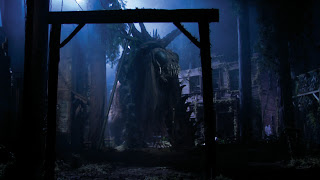Unless you're someone who enjoys a nice slice of cinematic cheese every so often, the majority of audiences hope that whatever film they've chosen to give the next two hours of their lives will be good, or at least entertaining. No one ever hopes for a bad film. On top of that, certain films command certain higher expectations, either because of the pedigree of talent involved, the source material that's inspired the plot, or because of the gimmick being utilized. Lost After Dark is one of those latter examples. A film built on resurrecting the dead teenager flicks of the 1980s, Lost After Dark had its heart in the right place and its blood all over the walls, but it didn't quite nail the mood, look, and feel it was attempting to evoke.
Speaking of heart in the right place, one thing that can be mentioned in the film's favor is that its adoration for the genre is ever in place, and director Ian Kessner and his co-writer Bo Randsel know their shit. From the cast of characters being named after beloved horror icons (the guys after horror directors, the girls after their muses), to lines of dialogue lifted from famous horror film sequences, even down to the poster design that is pure Jack Sholder's Alone in the Dark, the love that Lost After Dark's creators hold for the slasher genre is palpable and cannot be questioned, but unfortunately that love did not put them on their own path to contributing a memorable edition to the genre, either as a film itself, or at the least as a successful homage.
And that's where things get hairy: straddling the line between successful homage and standalone film. Throwback horror has returned to the genre in a big way over the last decade, ushered in by the likes Ti West's House of the Devil, Jim Mickle's Cold in July, and the Tarantino/Rodriguez opulence fest Grindhouse double feature. However, what Lost After Dark's filmmakers have failed to realize is that titles like House of the Devil or Cold in July or The Guest have something in common: not only do they successfully preserve the era of horror history they are homaging, but even if that aspect sails completely over a viewer's head, on their own they're still excellent films. Your having failed to see titles like Race with the Devil or The Tenant won't lessen your enjoyment of House of the Devil because on its own it still works quite well. If you've never seen a John Carpenter film in your entire life (what a dope!), you'll still be able to enjoy the eerie lunacy of It Follows.
The same can't be said for Lost After Dark, which is depending on your having seen a healthy dose of '80s horror to "get" it, but not offering a fresh take on well-worn concepts. Typical character archetypes are certainly on hand: the virginal lead, the wholesome boy next door, the asshole prepster, his bitchy socialite girlfriend, and yeah, the token black guy, complete with gigantic fake wig and hair pick. Rounding out the cast are the overweight pothead clearly emulating Shelly from Friday the 13th Part 3 (nice touch) and Frank Cunningham, aka Mr. C, who embodies The Shining's Dick Halloran in the form of the kids' high school principal (played by an utterly wasted Robert Patrick). And the filmmakers took great pains to utilize an '80s-infused visual design and texture, right down to the print damage and white speckling (which, weirdly, only show up every once in a while) attempting to give it the appearance of a film that's spent the last thirty years in storage. But very few moments of praise are reserved entirely for when it does circumvent expectations (which can't be discussed without spoilage), but not nearly enough of this kind of free-thinking was on hand to warrant separating Lost After Dark from the rest of its well-meaning but vapid colleagues.
The more romantic horror fan may find a lot to like about Lost After Dark, being that, as previously mentioned, its heart was in the right place and the dozens of odes to the horror genre (including a cameo from Rick Rosenthal, director of the pretty-good Halloween 2 and pretty-bad Halloween: Resurrection) will possibly make said horror devotee feel warm and fuzzy. As an homage, it ranks somewhere near the bottom of the pile, and as a standalone film judged entirely on its own efforts and not what came before, is hardly worth the effort or your time. Still, with it being a mindless, bloody and seldom clever ninety minutes of mayhem, sometimes for the less discerning horror fan, that can be enough. The throwback movement is still going strong, and thankfully has churned out some great titles, but unfortunately, Lost After Dark is left wandering around in the woods.






















